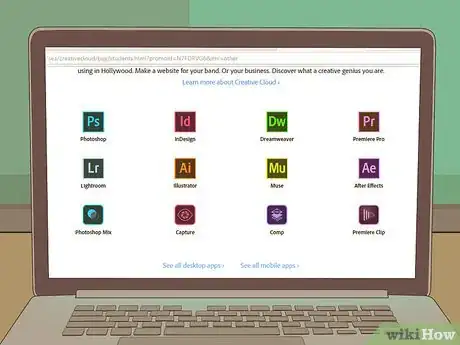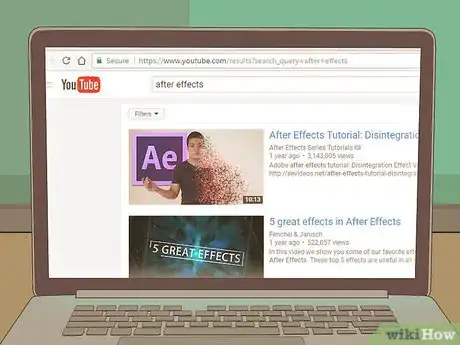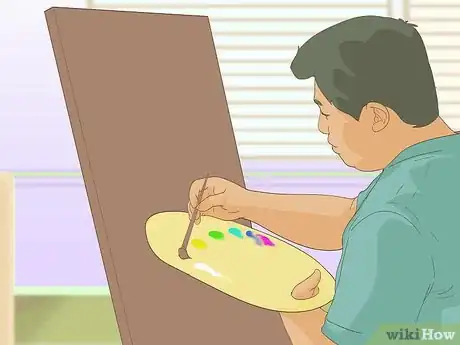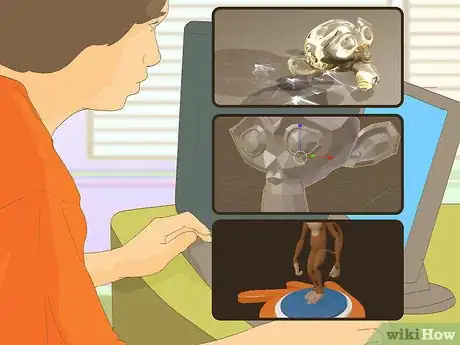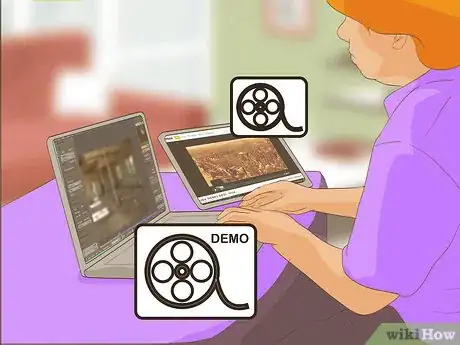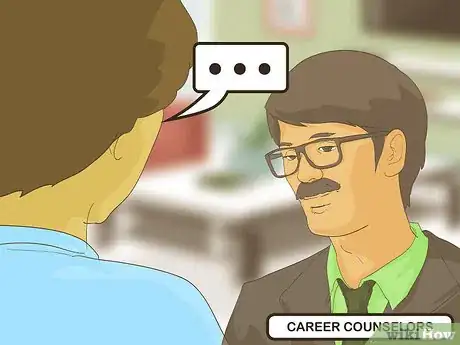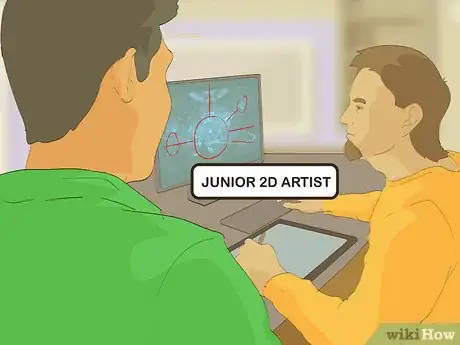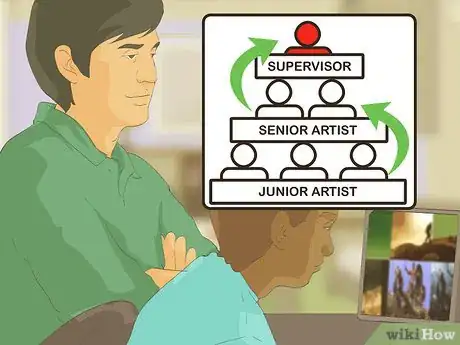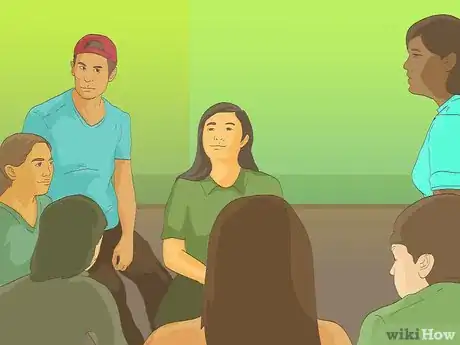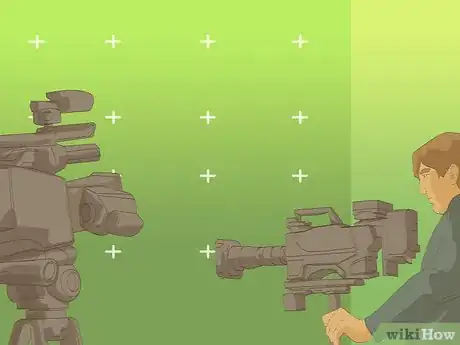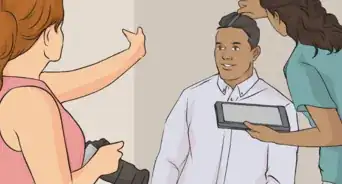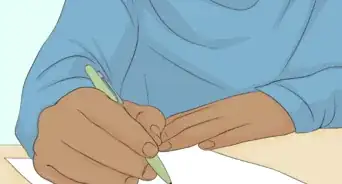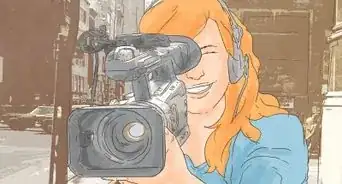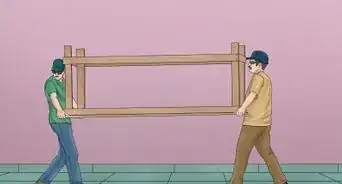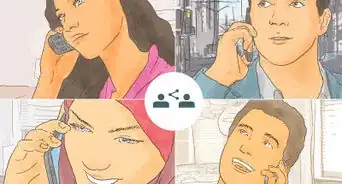This article was co-authored by Stephen Cardone. Stephen Cardone is the COO of NY Headshots, a New York City-based studio that specializes in shooting and producing headshots for individuals and businesses. Stephen has over four years of professional photography experience and over six years of documentary filmmaking experience. Stephen also works extensively as a photographer at NY Headshots. His work includes events, environmental photography, as well as headshots for actors, models, and corporate. He holds a BA in Non-fiction Writing from The New School.
There are 9 references cited in this article, which can be found at the bottom of the page.
wikiHow marks an article as reader-approved once it receives enough positive feedback. In this case, 95% of readers who voted found the article helpful, earning it our reader-approved status.
This article has been viewed 102,929 times.
Are you interested in creating some of the amazing effects that are present in movies or television shows? As a visual effects artist (VFX artist), you’ll be the one to add these elements to live action footage, resulting in an amazing final product. To get into this field, start by honing your skills at a traditional college or studio. Practice your computer-based imagery by watching tutorials or taking additional seminars. When you are ready, land a position at a studio or venture out as a self-employed artist and begin to create your magic!
Steps
Building Your Skill Set
-
1Get a bachelor’s degree. It is possible to become a VFX artist without a college degree, but the path is often easier with one. VFX artists usually major in fine arts, computer graphics, or animation. Choose a college with a reputation for strength in these areas and a reputation for good job placement for graduates. The availability of internships is another factor to consider.[1]
- Out of the jobs advertised for VFX artists, a majority at any given time specify a bachelor’s degree as a minimum requirement for applicants.[2]
-
2Enroll in a studio-based program. Some studios offer short-term programs for people who want to learn more about VFX artistry without pursuing a college degree. Enrolling in these programs can be expensive as financial aid isn’t always offered, but they usually have the most cutting edge technology for you to learn from.Advertisement
-
3Train on a number of VFX computer programs. Although you may create some hand sketches, the majority of your work will be completed on the computer using the most up-to-date programs. Stay informed about the newest software advances by following VFX blogs and taking online computer tutorials.[3]
- For example, VFX artists are expected to be well-versed in graphics and animation programs, such as Adobe Creative Suite and JavaScript.[4]
- Clearly list every program that you can work with on your resume.
-
4Watch online tutorials. Hop onto YouTube or another video service and search for VFX clip reels or demonstrations. Some of these videos will focus on a particular skill set, such as shading, which you then can practice on your own. Challenge yourself to mimic some of the more difficult tasks, or even try to improve upon the models used.[5]
-
5Nurture your artistic side. Take as many art and design classes as you can. Or, simply carry a sketch pad around with you to work on your basic animation skills. As you draw, consider factors such as lighting and framing. Even geometry skills can come in handy when creating a particular type of background or even a person’s face.
- Make a choice to become an observer of the world around you. Ask yourself: how could I capture the movement of the leaves? Or, in what situations do shadows appear?
-
6Pay close attention to movies, television shows, and video games. Watch all of these creations with an eye for detail. Look for the techniques used and any original approaches that you see. Research the artists and see what their backgrounds are and contact them if you like.[6]
- Find a shot in a movie or show that really speaks to you, and pause the TV right at that spot. Then, use whatever equipment you have to try to recreate that shot with a friend, paying special attention to the way the lighting influences the emotions and atmosphere in the scene.[7]
- Study the dialogue itself when you're watching scenes, but also pay attention to how much of the scene uses dialogue, as well as how a message is conveyed when no one is talking.[8]
- You might also study the blocking in shots, which is the way the actors move, as well as the way the shots are sequenced, which is the editing.[9]
-
7Develop a specialization. As you gain more experience, you’ll likely find yourself gravitating toward a certain aspect of design. This will become your “calling card” and directors and other professionals will seek you out for this type of work. To build your specialization, start choosing jobs with that emphasis and attend additional training seminars.[10]
- For example, some VFX specialists focus on human character’s faces, animal figures, or city backgrounds.
Choosing a Career Path
-
1Create a compelling reel or portfolio. This should be a short video showcasing the breadth and depth of your skills as an artist. Some choose to follow a storyline format while others cycle through a series of clips. Most college programs will give you time to create this work in your junior or senior years using professional grade equipment and software.[11]
- Your reel is also a chance for you to showcase any unique skills that you possess, such as drawing or sculpting.
- Don’t be afraid to work with other artists to create your reel. Showing that you can collaborate well with others is something that studios often look for when hiring.
-
2Land an internship. If you are enrolled in a VFX program, talk to your career counselors to see what opportunities might be available. If you are developing your skills on your own, reach out to studios to see if they have any spots for paid or unpaid interns. This will give a potential employer a chance to get to know you and might make it easier for them to hire you in the future.[12]
-
3Consider self-employment. Over half of VFX artists are their own bosses. Being a freelance designer gives you more control over your schedule and project selection. But, it also means that you will need to handle administrative tasks and could struggle with bringing in a consistent income.[13]
- If this path interests you, it would be wise to take a few classes in marketing and accounting. Getting established is a hard struggle that many self-employed artists face.[14]
- Choosing your own projects can mean that you’ll establish a specialty more quickly than you might in a large studio. However, affording the most recent design equipment may be tough, depending on how successful you are.
-
4Sign on with a design company or studio. This is a more traditional option where you agree to full or part-time employment with an established company. Your work schedule and salary will very much depend on the prominence of the company and the types of projects that come in. However, you may get the opportunity to work on some big Hollywood blockbusters or top-rated television shows![15]
- Get your foot in the door of larger companies by serving as a junior 2D artist or runner. A junior artist will assist those with seniority by creating basic outlines for scenery and the like. A runner literally runs sketches and communications between the VFX team and a director, for example.
-
5Move up to a supervisor position. With enough time, effort, and luck, you may get the chance to take on a leadership position for a project. As a supervisor, the final product that audiences see is your responsibility. You’ll take all of the raw images and make them fit together while working alongside the production team.[16]
-
1Join a professional society. Networking is a great way to find new opportunities and exchange ideas. Start establishing your network as soon as you decide to become a VFX artist. Join an industry group, such as the Visual Effects Society (VES). If you can’t fully join, then simply follow their activities and attend events when you can.[17]
- The VES has almost 3,400 members spread across the entire world. Their work ranges from video games to television.[18]
-
2Enjoy working with a team. Most VFX work situations will require that you communicate with a number of people as you complete a task. You may need to talk with directors, other VFX artists, and animators to create a unified vision for the final product. Taking communication courses in college is only one way you can learn how to communicate effectively.[19]
- This also means that you will need to find ways to work with constructive criticism and feedback. Altering your final product based on information from the wider production team is often something that you just have to do. For example, a director might ask you to cut down a scene that you’ve spent weeks working on.
- Pitching your creative vision and ideas to others is also an important part of the process. If you can make a product more memorable in an advertisement, for instance, then the creative team probably wants to know.
-
3Expect long work hours. Most VFX artists start work mid-morning and go until the late evening. Or, your shift could be an overnight one that ends in the early morning hours. The schedule very much depends on the deadlines that are looming and how the work is divided over time. You’ll want to be prepared for unpredictable timelines as a VFX artist.[20]
- Partially due to the long hours, many VFX professionals describe their work setting as being pretty laid back in terms of dress and even behavior.
-
4Spend time on a TV or film set. If you are considering working in the entertainment industry, try to get out of your office and away from your computer and head to the actual sets. This will give you a chance to see how the production team works together on the ground. Pay attention to how each person’s job feeds into the final product.[21]
Expert Q&A
-
QuestionCan watching other people's films improve my skills as a filmmaker?
 Stephen CardoneStephen Cardone is the COO of NY Headshots, a New York City-based studio that specializes in shooting and producing headshots for individuals and businesses. Stephen has over four years of professional photography experience and over six years of documentary filmmaking experience. Stephen also works extensively as a photographer at NY Headshots. His work includes events, environmental photography, as well as headshots for actors, models, and corporate. He holds a BA in Non-fiction Writing from The New School.
Stephen CardoneStephen Cardone is the COO of NY Headshots, a New York City-based studio that specializes in shooting and producing headshots for individuals and businesses. Stephen has over four years of professional photography experience and over six years of documentary filmmaking experience. Stephen also works extensively as a photographer at NY Headshots. His work includes events, environmental photography, as well as headshots for actors, models, and corporate. He holds a BA in Non-fiction Writing from The New School.
Professional Photographer This is a great way to learn some of the basics of filmmaking. Find your favorite shot in a movie, pause it, and try to break down why it speaks to you. Pay attention to how all of the elements work together, including the lighting, the action and interaction between the characters, the dialogue, the blocking, and the editing.
This is a great way to learn some of the basics of filmmaking. Find your favorite shot in a movie, pause it, and try to break down why it speaks to you. Pay attention to how all of the elements work together, including the lighting, the action and interaction between the characters, the dialogue, the blocking, and the editing. -
QuestionCan an 11th-grader become a graphic designer?
 Community AnswerYes, you can become a graphic designer, all you need to do is to be artistic and familiarity with the software for graphic designing (Serif DrawPlus, CorelDraw Home & Student Suite, Corel PaintShop Pro, Adobe Photoshop Elements, among others). You can find tutorials for the software online.
Community AnswerYes, you can become a graphic designer, all you need to do is to be artistic and familiarity with the software for graphic designing (Serif DrawPlus, CorelDraw Home & Student Suite, Corel PaintShop Pro, Adobe Photoshop Elements, among others). You can find tutorials for the software online. -
QuestionCan a teen become a visual effects artist?
 MohomedCommunity AnswerYes, as long as you have the skills required. All you need to do is be artistic and familiarity with the software for graphic designing (Adobe After Effects, CorelDraw Home & Student Suite, Corel PaintShop Pro, Adobe Photoshop Elements, among others).
MohomedCommunity AnswerYes, as long as you have the skills required. All you need to do is be artistic and familiarity with the software for graphic designing (Adobe After Effects, CorelDraw Home & Student Suite, Corel PaintShop Pro, Adobe Photoshop Elements, among others).
Warnings
- Try to keep aware of what controversies and debates are circulating in the VFX field. For example, read the VFX forums online to see if any particular studios are facing pay or overtime disputes.[23]⧼thumbs_response⧽
References
- ↑ http://www.rasmussen.edu/degrees/design/blog/beginners-guide-to-becoming-visual-effects-artist/
- ↑ http://www.rasmussen.edu/degrees/design/blog/beginners-guide-to-becoming-visual-effects-artist/
- ↑ http://www.rasmussen.edu/degrees/design/blog/beginners-guide-to-becoming-visual-effects-artist/
- ↑ http://www.rasmussen.edu/degrees/design/blog/beginners-guide-to-becoming-visual-effects-artist/
- ↑ https://www.linkedin.com/pulse/5-tips-become-great-visual-effects-artist-school-of-pixels
- ↑ http://freakonomics.com/podcast/no-hollywood-ending-visual-effects-industry/
- ↑ Stephen Cardone. Professional Photographer. Expert Interview. 5 May 2020.
- ↑ Stephen Cardone. Professional Photographer. Expert Interview. 5 May 2020.
- ↑ Stephen Cardone. Professional Photographer. Expert Interview. 5 May 2020.
- ↑ http://www.rasmussen.edu/degrees/design/blog/beginners-guide-to-becoming-visual-effects-artist/
- ↑ https://www.vanarts.com/programs/visual-effects-for-film-television/
- ↑ http://www.academicinvest.com/arts-careers/fine-arts-careers/how-to-become-a-visual-effects-artist
- ↑ http://www.rasmussen.edu/degrees/design/blog/beginners-guide-to-becoming-visual-effects-artist/
- ↑ http://www.academicinvest.com/arts-careers/fine-arts-careers/how-to-become-a-visual-effects-artist
- ↑ http://www.rasmussen.edu/degrees/design/blog/beginners-guide-to-becoming-visual-effects-artist/
- ↑ https://www.gnomon.edu/blog/visual-effects-career-paths-what-it-takes-to-be-a-vfx-supervisor
- ↑ https://www.visualeffectssociety.com/
- ↑ https://www.visualeffectssociety.com/
- ↑ http://www.rasmussen.edu/degrees/design/blog/beginners-guide-to-becoming-visual-effects-artist/
- ↑ http://www.rasmussen.edu/degrees/design/blog/beginners-guide-to-becoming-visual-effects-artist/
- ↑ https://www.gnomon.edu/blog/visual-effects-career-paths-what-it-takes-to-be-a-vfx-supervisor
- ↑ https://www.linkedin.com/pulse/5-tips-become-great-visual-effects-artist-school-of-pixels
- ↑ https://www.thebillfold.com/2013/02/why-there-were-400-visual-effects-artists-protesting-at-the-oscars/


